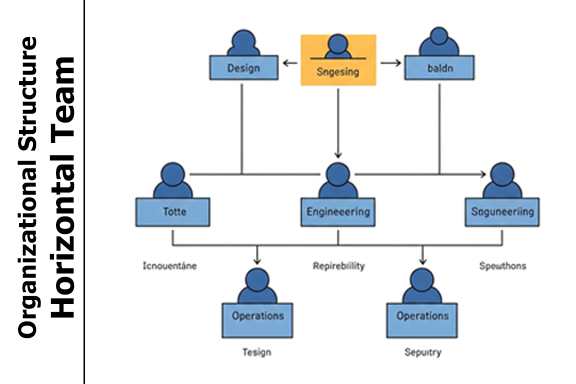Learn about Organizational Structure for Agile Practices
Agile practices emphasize flexibility, collaboration, and cross-functional teams to adapt to changing requirements and deliver value efficiently. Two common organizational structures used to implement Agile are Horizontal Teams and Vertical Teams. Each structure serves different purposes and benefits depending on the organizational context.
1. Horizontal Teams

Horizontal teams are cross-functional teams consisting of members from different roles and departments (e.g., development, testing, business analysts, UX/UI designers). These teams focus on delivering specific features or outcomes across the entire lifecycle of a product.
Key Characteristics
Cross-functional: Members from various disciplines collaborate together.
Feature-Focused: Focus on delivering complete features or end-to-end solutions.
Collaboration-Oriented: Emphasizes teamwork across roles.
Benefits
Facilitates end-to-end ownership of features.
Encourages holistic thinking and a shared understanding of project goals.
Reduces bottlenecks between departments, ensuring smooth delivery.
Challenges
Requires frequent communication between teams, leading to potential coordination overhead.
Resource availability across functions may create conflicts or delays.
2. Vertical Teams

Vertical teams are aligned with specific product domains or business areas. They include members from multiple disciplines, but each team focuses on a particular part of the product or business function.
Key Characteristics
Specialized: Focused on specific domains or business areas (e.g., customer support, finance, operations).
Domain-Specific: Develops deep expertise in its respective area.
Clear Accountability: Focuses on complete delivery within its scope.
Benefits
Deep specialization in business areas or domains.
Better alignment with business objectives and key results (OKRs).
Easier tracking of domain-specific outcomes and performance metrics.
Challenges
Can lead to silos if teams are too focused on their specific domains without cross-functional collaboration.
Risk of duplication or misalignment with other areas.
Comparison of Horizontal vs. Vertical Teams
| Aspect | Horizontal Teams | Vertical Teams |
|---|---|---|
| Structure | Cross-functional, working across entire features | Focused on specific domains or business areas |
| Collaboration | Emphasizes teamwork across disciplines | Specialized within specific functions |
| Responsibility | End-to-end responsibility for features or products | Focused on specific deliverables within a domain |
| Flexibility | Higher adaptability to change | Less adaptable, but deep domain expertise |
| Communication | Frequent communication across teams | Focused communication within specific functions |
| Alignment | Broad, across product areas | Deep alignment with domain-specific objectives |
Which Structure Works Best?
Horizontal Teams work well for delivering complex, integrated features across multiple disciplines.
Vertical Teams are ideal for specialized domains that require deep expertise and focused outcomes within specific business areas.
Implementation Considerations
Hybrid Approaches: Many organizations combine elements of both horizontal and vertical teams to balance specialization and cross-functional collaboration.
Agile Frameworks: SAFe, LeSS, and other frameworks often combine horizontal and vertical elements for scaled agile delivery.
Please let me know through comments, if you would like more details on either structure or examples of successful implementation?






















Leave a Reply